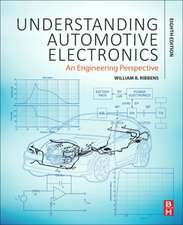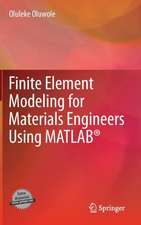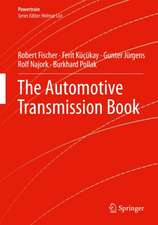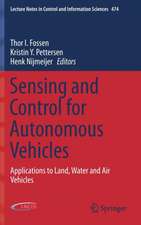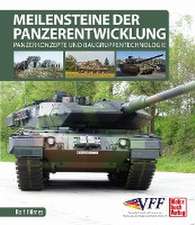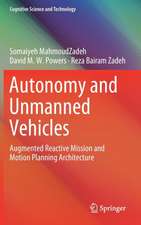Automotive Software Architectures: An Introduction
Autor Miroslaw Staronen Limba Engleză Paperback – 4 mar 2022
This book introduces the concept of software architecture as one of the cornerstones of software in modern cars. Following a historical overview of the evolution of software in modern cars and a discussion of the main challenges driving that evolution, Chapter 2 describes the main architectural styles of automotive software and their use in cars’ software. Chapter 3 details this further by presenting two modern architectural styles, i.e. centralized and federated software architectures. In Chapter 4, readers will find a description of the software development processes used to develop software on the car manufacturers’ side. Chapter 5 then introduces AUTOSAR – an important standard in automotive software. Chapter 6 goes beyond simple architecture and describes the detailed design process for automotive software using Simulink, helping readers to understand how detailed design links to high-level design. The new chapter 7 reports on how machine learning is exploited in automotive software e.g. for image recognition and how both on-board and off-board learning are applied. Next, Chapter 8 presents a method for assessing the quality of the architecture – ATAM (Architecture Trade-off Analysis Method) – and provides a sample assessment, while Chapter 9 presents an alternative way of assessing the architecture, namely by using quantitative measures and indicators. Subsequently Chapter 10 dives deeper into one of the specific properties discussed in Chapter 8 – safety – and details an important standard in that area, the ISO/IEC 26262 norm. Lastly, Chapter 11 presents a set of future trends that are currently emerging and have the potential to shape automotive software engineering in the coming years.
This book explores the concept of software architecture for modern cars and is intended for both beginning and advanced software designers. It mainly aims at two different groups of audience – professionals working with automotive software who need to understandconcepts related to automotive architectures, and students of software engineering or related fields who need to understand the specifics of automotive software to be able to construct cars or their components. Accordingly, the book also contains a wealth of real-world examples illustrating the concepts discussed and requires no prior background in the automotive domain. Compared to the first edition, besides the two new chapters 3 and 7 there are considerable updates in chapters 5 and 8 especially.
This book explores the concept of software architecture for modern cars and is intended for both beginning and advanced software designers. It mainly aims at two different groups of audience – professionals working with automotive software who need to understandconcepts related to automotive architectures, and students of software engineering or related fields who need to understand the specifics of automotive software to be able to construct cars or their components. Accordingly, the book also contains a wealth of real-world examples illustrating the concepts discussed and requires no prior background in the automotive domain. Compared to the first edition, besides the two new chapters 3 and 7 there are considerable updates in chapters 5 and 8 especially.
| Toate formatele și edițiile | Preț | Express |
|---|---|---|
| Paperback (2) | 331.40 lei 6-8 săpt. | |
| Springer International Publishing – 12 mai 2018 | 331.40 lei 6-8 săpt. | |
| Springer International Publishing – 4 mar 2022 | 389.31 lei 6-8 săpt. | |
| Hardback (1) | 394.54 lei 3-5 săpt. | +26.24 lei 6-10 zile |
| Springer International Publishing – 3 mar 2021 | 394.54 lei 3-5 săpt. | +26.24 lei 6-10 zile |
Preț: 389.31 lei
Preț vechi: 486.63 lei
-20% Nou
Puncte Express: 584
Preț estimativ în valută:
74.50€ • 76.97$ • 62.01£
74.50€ • 76.97$ • 62.01£
Carte tipărită la comandă
Livrare economică 26 martie-09 aprilie
Preluare comenzi: 021 569.72.76
Specificații
ISBN-13: 9783030659417
ISBN-10: 3030659410
Pagini: 274
Ilustrații: XX, 274 p. 174 illus., 47 illus. in color.
Dimensiuni: 155 x 235 mm
Greutate: 0.42 kg
Ediția:2nd ed. 2021
Editura: Springer International Publishing
Colecția Springer
Locul publicării:Cham, Switzerland
ISBN-10: 3030659410
Pagini: 274
Ilustrații: XX, 274 p. 174 illus., 47 illus. in color.
Dimensiuni: 155 x 235 mm
Greutate: 0.42 kg
Ediția:2nd ed. 2021
Editura: Springer International Publishing
Colecția Springer
Locul publicării:Cham, Switzerland
Cuprins
1 Introduction.- 2. Software Architectures—Views and Documentation.- 3. Contemporary Software Architectures: Federated and Centralized.- 4. Automotive Software Development.- 5. AUTOSAR (AUTomotive Open System ARchitecture).- 6. Detailed Design of Automotive Software.- 7. Machine Learning in Automotive Software.- 8. Evaluation of Automotive Software Architectures.- 9. Metrics for Software Design and Architectures.- 10. Functional Safety of Automotive Software.- 11. Current Trends in Automotive Software Architectures.- 12 Summary.
Notă biografică
Miroslaw Staron is Professor in the Department of Computer Science and Engineering at the University of Gothenburg, Sweden. He has published extensively on software metrics, model-driven software development and empirical software engineering and cooperates with Ericsson, Volvo and other telecom companies and car manufacturers.
Textul de pe ultima copertă
This book introduces the concept of software architecture as one of the cornerstones of software in modern cars. Following a historical overview of the evolution of software in modern cars and a discussion of the main challenges driving that evolution, Chapter 2 describes the main architectural styles of automotive software and their use in cars’ software. Chapter 3 details this further by presenting two modern architectural styles, i.e. centralized and federated software architectures. In Chapter 4, readers will find a description of the software development processes used to develop software on the car manufacturers’ side. Chapter 5 then introduces AUTOSAR – an important standard in automotive software. Chapter 6 goes beyond simple architecture and describes the detailed design process for automotive software using Simulink, helping readers to understand how detailed design links to high-level design. The new chapter 7 reports on how machine learning is exploited in automotive software e.g. for image recognition and how both on-board and off-board learning are applied. Next, Chapter 8 presents a method for assessing the quality of the architecture – ATAM (Architecture Trade-off Analysis Method) – and provides a sample assessment, while Chapter 9 presents an alternative way of assessing the architecture, namely by using quantitative measures and indicators. Subsequently Chapter 10 dives deeper into one of the specific properties discussed in Chapter 8 – safety – and details an important standard in that area, the ISO/IEC 26262 norm. Lastly, Chapter 11 presents a set of future trends that are currently emerging and have the potential to shape automotive software engineering in the coming years.
This book explores the concept of software architecture for modern cars and is intended for both beginning and advanced software designers. It mainly aims at two different groups of audience – professionals working with automotive software who need to understandconcepts related to automotive architectures, and students of software engineering or related fields who need to understand the specifics of automotive software to be able to construct cars or their components. Accordingly, the book also contains a wealth of real-world examples illustrating the concepts discussed and requires no prior background in the automotive domain. Compared to the first edition, besides the two new chapters 3 and 7 there are considerable updates in chapters 5 and 8 especially.
This book explores the concept of software architecture for modern cars and is intended for both beginning and advanced software designers. It mainly aims at two different groups of audience – professionals working with automotive software who need to understandconcepts related to automotive architectures, and students of software engineering or related fields who need to understand the specifics of automotive software to be able to construct cars or their components. Accordingly, the book also contains a wealth of real-world examples illustrating the concepts discussed and requires no prior background in the automotive domain. Compared to the first edition, besides the two new chapters 3 and 7 there are considerable updates in chapters 5 and 8 especially.
Caracteristici
First textbook on software engineering for automotive systems, combining both theoretical and practical issues from academic courses and industrial experience Includes a wealth of real-world examples, suggestions for further reading, and comprehensive summaries at the end of each chapter Introduces important standards and methods like AUTOSAR, Simulink, ATAM, and ISO/IEC 26262 Second Edition contains new chapters on federated software architectures and machine learning for automotive systems
Recenzii
“An experienced software architect could read the book over a weekend due to the excellent organization and lucidity of the writing. This is a perfect reference and companion book for a short course or workshop on automotive software engineering for software professionals transitioning to the automotive industry from other sectors.” (Sundara Nagarajan, Computing Reviews, March, 2018)

